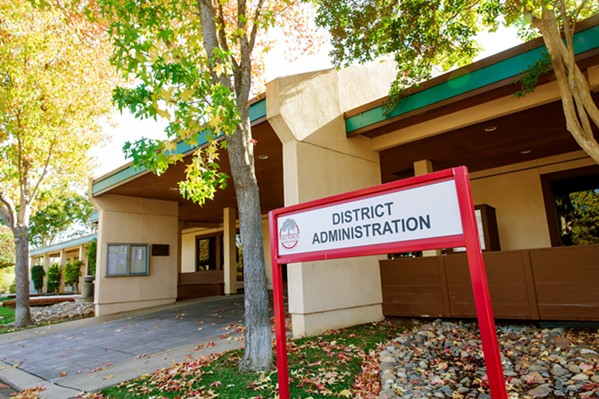A combination of legislation and litigation is encouraging—or rather, forcing—the Paso Robles Joint Unified School District to move to by-district elections for its board of trustees.
But one trustee isn't having it.
"I think this whole thing is shady," said Trustee Dorian Baker at the board's Jan. 25 meeting.
Given that the California Voting Rights Act (CVRA) became law two decades ago, Baker was confused about why the board is only now moving away from at-large elections.
The short answer: "A lawsuit," Trustee Chris Bausch replied.

- File Photo By Jayson Mellom
- DISTRICT CHANGES The Paso Robles Joint Unified School District board of trustees decided on a final map to be used for future board elections. The school district moved to by-trustee area elections, rather than at-large, due to looming legal threats.
The CVRA prohibits the use of any election system that makes it harder for a protected class to elect candidates of its choice or influence an election. To achieve this, the act allows plaintiffs to sue jurisdictions that still use at-large elections, like the Paso school district.
Bausch told New Times that the district received a letter at the beginning of 2019 from Kevin Shenkman, a lawyer with Shenkman & Hughes, alleging that the district had violated the CVRA in its continued use of at-large elections.
"The letter threatens legal action in San Luis Obispo County Superior Court unless the district transitions to district-based elections," Bausch said in an email. "At that time, no government agency had prevailed in court in defending an at-large voting system like the one then in use by the district."
By-district elections divide municipalities into subsections and require board hopefuls to reside in the district that they're running in—plus, candidates can only get votes from the people who live in their district. The idea is that by-district elections give underrepresented voters a better shot at electing people who represent them.
With the threat of a lawsuit looming, the board began its process to divvy up the school district's jurisdiction into seven subsections of roughly equal populations. Each section can have small variances, up to 10 percent, in order to preserve communities of interest or to prevent the dilution of a racial minority.
Once the 2020 census results were released, the board refined its maps and narrowed them down to two options. Scenario 2 was approved at the Jan. 25 meeting.
One of Baker's chief concerns with moving to a by-district system is the possibility that candidates won't step up to run in all seven districts. Because the last group of board members was elected at-large, there are some districts in the new map that don't have any trustees currently representing them.
Dan McElhinney, the Paso school district's legal counsel, explained that if no community member steps up to run in a certain district, then there would be a vacancy, which would be filled with a provisional appointment.
"So then the people wouldn't be selecting," Baker replied. "They would lose out on their opportunity to elect a representative at-large. ... My worry is that it would politicize the board."
McElhinney explained that the people would not be losing out on an opportunity to vote someone in, because anyone could have stepped up to run for the district they live in.
"If nobody from their own district wants to run, that's their choice," Trustee Nathan Williams chimed in. "They had that opportunity."
Baker didn't back down from her stance.
"I don't even see how it's constitutional to break people down into protected classes like this," she said. "Junky laws like this get passed at the state and federal levels with little or no pushback at local levels. Yet, we are supposed to be governed from the local level up, not up-down. ... My constituents are asking me, 'Why are you doing this?' Well, I am not doing this."
But for some Paso Robles locals, the move to by-district elections is long overdue.
Paso People's Action has been a big proponent for getting a more accurate representation of the community on the school board, which is currently majority male and white. According to 2020 census data, Paso Robles is 34 percent Hispanic/Latino—up from 29 percent in 2010—and about 58 percent white.
"The school board right now does not represent the population that it serves, and that is a problem," Yessenia Echevarria, co-founder of Paso People's Action, told New Times. "[Trustee Baker] thinks that these district maps are going to politicize the board. Well, the board is already politicized."
Board President Chris Arend shared some of Baker's concerns, but said that the board's hands are tied.
"I agree this is foolish, but we aren't the ones who make the call," Arend said. "In this case, it was the courts in the state of California that have made the call, and that's the way it is with separation of powers."
The board voted 6-1 to approve the map, with Baker being the only dissenting vote.
The map will now go to the County Office of Education to be approved, Trustee Bausch told New Times. The newly formed trustee areas 1, 2, and 4 will be up for election later this year, while areas 3, 5, 6, and 7 will be up for election in 2024. Δ
Reach Staff Writer Malea Martin at [email protected].
Comments
Showing 1-1 of 1